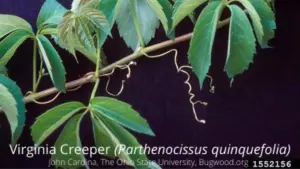
By Angie Naughton, Denton County Master Gardener Association
The new spring growth of Virginia creeper sometimes displays a three-leaf pattern similar to poison ivy making it difficult to differentiate the two plants.
Poison ivy has compound leaves containing three leaflets and the leaf margin appearance varies greatly. The center leaflet has a longer stalk than the side leaflets, which are always directly opposite each other. A cluster of off-white berries form in spring and will remain all winter. It uses aerial roots to climb structures. Older vines have an apparent hairy appearance due to the aerial roots, and they contain the same irritating chemical as the rest of the plant.
Virginia creeper has compound leaves consisting of up to five leaflets with serrated leaf margins. In early growth, it may only show three leaflets, with more leaflets appearing over time. Individual leaflets radiate uniformly from the center with virtually equal stalk lengths. Greenish spring blooms produce berries that ripen to a black or dark blue in the late fall. The vine uses tendrils and adhesive discs to climb structures. Young vines exhibit finely hairy growth, but as the vines mature, they lose the hairy appearance.
A poison ivy control measure includes pulling the immature plant when the soil is moist. To protect the skin, wear gloves, a long-sleeved shirt, and long pants tucked into socks. Tools and clothes will have to be washed after pulling because the plant’s skin irritant can be transferred from those items to the skin.
Another poison ivy control measure is a chemical method that involves cutting the poison ivy vine and immediately brushing the open cut with an herbicide labeled for poison ivy. Always wear the personal protective equipment as directed on the herbicide label and follow all usage instructions.
For more information about gardening in North Texas see dcmga.com/north-texas-gardening.
Happy Gardening!

















